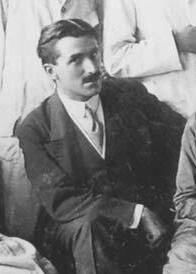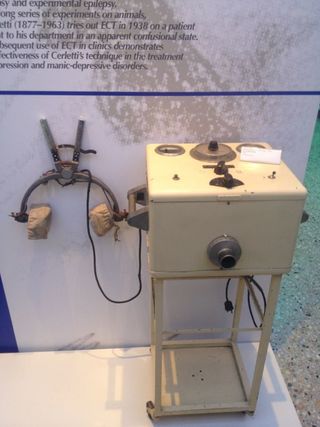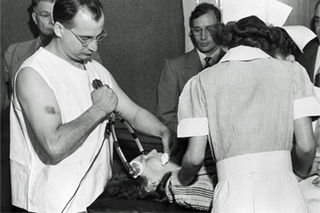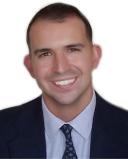Psychiatry
A Brief History of Electroconvulsive Therapy
The story of a misunderstood but effective treatment.
Posted November 3, 2018 Reviewed by Abigail Fagan
Of all treatments in contemporary psychiatry, perhaps none is more commonly misunderstood than electroconvulsive therapy (ECT). Its depiction in the popular media and in movies such as One Flew Over the Cuckoo's Nest has contributed to its controversial reputation in the general public.
Yet research indicates that nearly 80 years after its discovery, ECT remains the single most effective therapy for treatment-resistant cases of depression and some cases of bipolar affective disorder and schizophrenia.
Although its exact mechanism of action is unknown, electroconvulsive therapy works by inducing seizure activity via electricity in the frontal lobes of the brain. The treatment itself lasts only several minutes, and a usual course of ECT involves treatment two or three times a week for a few weeks, followed by maintenance therapy on an outpatient basis.
ECT can be given either unilaterally, across one hemisphere of the brain, or bilaterally, across the whole brain. While commonly thought of as a last-line treatment, there are some circumstances in which ECT is given earlier in the treatment course, such as severe or life-threatening catatonia.

Like many treatments in psychiatry and medicine more generally, ECT was discovered serendipitously (see Lieberman & Ogas, 2015). Early asylum keepers recognized that the symptoms of psychotic patients who also suffered from epilepsy seemed to improve after having a seizure. The Portuguese psychiatrist Ladislas Meduna began experimenting with different ways to induce seizures, and in 1934 discovered that Metrazol, a stimulant drug, produced seizures if given in high enough doses. Amazingly, Meduna noted that his patients' psychotic symptoms did, in fact, diminish after a Metrazol-induced seizure. This novel treatment quickly became known as convulsive therapy.
In 1937, the first international conference on pharmacologic convulsive therapy was organized in Switzerland by the Swiss psychiatrist Max Müller. By this time, however, it was realized that there were a few problems associated with this treatment, most notably, the fact that Metrazol produced violent thrashing convulsions which would commonly result in vertebral fractures. Additionally, the drug would produce a feeling of morbid apprehension before the convulsions began. For these reasons, psychiatrists began searching for alternative ways to induce seizures.

Around the same time, Italian neurologist Ugo Cerletti was experimenting with seizure induction in dogs by delivering electrical shocks directly to their heads. Psychiatric legend holds that Cerletti was shopping at a butcher shop one day in Italy and noticed that the butcher would deliver an electrical shock to the heads of pigs before slaughtering them. The electricity caused the animal to enter an anesthetized coma-like state. Cerletti wondered whether electricity applied to the heads of human patients would similarly produce anesthesia before provoking convulsions. Electroconvulsive therapy was born.
In 1938, Cerletti and his psychiatrist colleague Lucio Bini developed the first ECT device and treated their first human patient, a diagnosed schizophrenic with delusions, hallucinations, and confusion. The treatment worked just as planned, and the patient's condition improved markedly. Beginning in the 1940s, the electrical technique was adopted by almost every major psychiatric institution around the world as a treatment for serious mental disease. In the United States, ECT was advanced by psychiatrists Lothar Kalinowsky and Max Fink, among others. Fink remains professor emeritus of psychiatry and neurology at the State University of New York at Stony Brook and has continued to write about the merits of ECT. For their pioneering work on ECT, Cerletti and Bini were nominated for a Nobel Prize in Medicine in the 1930s.

In the 1950s, a new wave in psychiatry was ushered in with the advent of chlorpromazine, the early antidepressants, and the discovery of lithium's effectiveness as a mood stabilizer. Yet, it was ECT that represented the first major breakthrough in biological psychiatry. All of these developments contributed to the gradual closure of state mental hospitals in the United States.
In the 1960s, psychiatrist Thomas Szasz spearheaded what came to be known as the "antipsychiatry movement" which attacked psychiatry on multiple fronts, including the practice of ECT, viewed as inhumane and torturous. ECT fell out of favor in the 1960s and 1970s, but it made a resurgence in the 1980s. Today, it is a widely accepted treatment for serious mental disorders and is taught and practiced at hospitals throughout the world. It is estimated that one million people receive ECT annually (Leiknes, Schweder, & Høie, 2012).
ECT's discovery as an effective treatment for severe mental disorder represented the first real hope for patients once considered to be untreatable, and it continues to offer many patients relief from otherwise unrelenting and debilitating psychiatric symptoms. Its story reveals a history that is just as remarkable as its well-established effectiveness.
For a more thorough history of electroconvulsive therapy, see Jeffrey Lieberman's excellent book Shrinks: The Untold Story of Psychiatry.
References
Leiknes, K. A., Jarosh-von Schweder, L., & Høie, B. (2012). Contemporary use and practice of electroconvulsive therapy worldwide. Brain and Behavior, 2(3), 283-344.
Lieberman, J. A., & Ogas, O. (2015). Shrinks: The untold story of psychiatry. New York: Little, Brown and Company.




